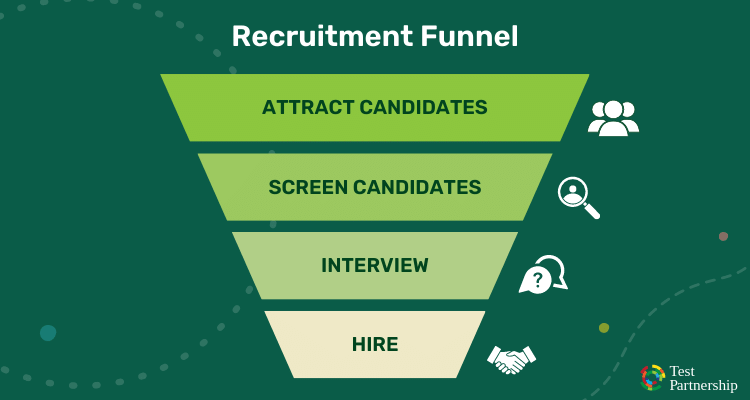How to Assess Soft Skills in Candidates: The Proven, Research-Backed Method
How to assess soft skills with reliable, science-backed methods proven to improve hiring accuracy and efficiency.

Recruitment is a crucial process for any business as it greatly impacts an organisation's success. The right employees bring in new skills, ideas, and energy, while the wrong employees can be a costly drain on company resources. As HR professionals, it is important to develop a recruitment funnel to attract the right talent while reducing the cost and time involved in the recruitment process.
In this article, we will explore how to build an effective and efficient recruitment funnel, with tips and expert advice from HR professionals.
If you would prefer to watch a video, here is Ben talking about how to build a recruitment funnel:
A recruitment funnel is a visual representation of the recruitment process, outlining the steps a candidate takes from initial awareness of the company to final selection for the job. The funnel serves as a roadmap for HR professionals, helping them understand where potential candidates are in the process and what needs to be done to move them to the next stage.
Here is a sample recruitment funnel that we have created for you (we will go through each of these steps in depth further down the page):

A recruitment funnel is crucial as it serves as a structured process for sourcing, evaluating, and hiring candidates. Here are the top six reasons why recruitment funnels are important:
In essence, a recruitment funnel ensures a structured, efficient, and effective hiring process, aligning the company's needs with the best talents available in the job market.
Creating a recruiting funnel involves structuring and organising the steps of the hiring process to attract, evaluate, and hire the best candidates efficiently. We will talk about each of the four steps in the recruitment funnel further down, but here is what you will need to do before creating a recruitment funnel:
The first step in the recruitment funnel is attracting candidates. This involves creating a strong employer brand, establishing an online presence, and using job postings and other recruitment marketing tools to reach potential candidates.
Creating a strong employer brand highlights the company's culture, values, and mission through online content such as company videos, employee testimonials, and social media posts.
Establishing an online presence can be done through websites, career pages, and social media platforms that should be regularly updated to ensure potential candidates have access to the latest information about the company.
In addition, job postings and other recruitment marketing tools such as advertisements and social media reach a wide audience of potential candidates. It is important to ensure that job postings are well written with a clear description of the role and company culture and posted on a variety of relevant job boards and social media platforms.
You will want to measure how effective each source of hire was; identify where successful candidates originated from (job boards, referrals, social media, etc.) as certain sources may have a greater quality of job seeker.
Cost per hire is a very important metric to be using. Cost per hire will tell you the average cost incurred to hire a candidate from a specific source, or you can calculate it overall (irrespective of source).
Once potential candidates have been attracted, it’s time to screen them. This involves reviewing resumes, conducting preliminary interviews, and using psychometric assessments to determine if the candidate is a good fit for the role and the company. Online psychometrics also have the advantage of greatly speeding up the short-listing process, saving the HR team from hundreds of hours’ worth of interviewing.
Psychometric assessments can provide valuable insights into a candidate’s work preferences, personality traits, and cognitive abilities, helping HR professionals to identify individuals who are likely to be a good fit for the role and the company. By short-listing based on psychometric assessments, organisations can also significantly improve the fairness and objectivity of their selection processes. Naturally, human beings are vulnerable to conscious and unconscious biases, hindering the effectiveness of D&I initiatives.
However, it is important to choose a reputable provider and ensure that the assessments are valid and reliable. Additionally, it is essential to use assessments in conjunction with other selection tools, such as interviews and reference checks, to gain a comprehensive understanding of an individual’s suitability for the role.
There are a few key metrics you can use to measure the effectiveness of this stage of the recruitment funnel:

Why teams choose Test Partnership
Smarter hiring starts here - with adaptive assessments, expert support, and science you can trust.
How we're differentThe next step is to conduct face-to-face interviews. This allows HR professionals to further assess a candidate’s skills, experience, and cultural fit, and to determine if they are a good match for the role.
It is important to prepare a list of interview questions in advance, and to ensure that the interview process is consistent and fair for all candidates.
Research shows that structured interviews i.e. questions with a fixed set of questions, tend to outperform unstructured interviews when predicting job performance. Consequently, HR practitioners and hiring managers should always take the time to plan out their interviews, drafting question and additional probing questions beforehand.
Here there are two main metrics you may wish to use to measure the effectiveness of this stage:
Once the interview process is complete, it is time to select the candidate who is the best fit for the role. This decision should be based on a combination of factors, including the candidate’s skills, experience, cultural fit, and the results of the psychometric assessments. By combining all of these information sources, organisations can maximise the probability of making good hires, selecting the best candidates from the recruitment funnel.
For metrics to measure the hiring effectiveness stage you may wish to use the following:
Stay updated with my latest tips, insights, and advice to help you stay ahead in your industry.
The concepts of a recruitment funnel helps visualise the nature of the selection process. Initially, a large number of applicants express an interest, but only a few are progressed to the next stage. This process continues until a very concise list of successful applicants are selected, following the shape of a funnel. By thinking of recruitment in these terms, HR practitioners can address each stage within the recruitment funnel appropriately, with the express aim of condensing a large applicant pool into a small subset of high-potential applicants quickly, effectively, and efficiently.
Once the recruitment process has been completed it is important to measure and optimise what has taken place. Continuously track and analyse your recruitment metrics (conversion rates, time-to-fill, quality of hires, etc.) to identify areas for improvement. Use feedback from candidates and hiring teams to refine the process and enhance candidate experience.
Regularly review the effectiveness of the recruiting funnel. Implement changes based on data analysis and feedback to continually refine and optimise the process. And that's how you create and optimise a recruitment funnel!
Funnel analysis in recruitment involves examining and optimising the stages of the recruitment process, much like a funnel where candidates move through different stages, from awareness of a job opening to becoming a hired employee. It's a method used to track and analyse the flow of candidates at each stage of the hiring process to identify bottlenecks, areas for improvement, and opportunities for optimisation.
By analysing these metrics, recruiters and hiring managers can identify where candidates might drop out of the process, where delays occur, or which sources yield the best candidates. This analysis helps in optimising the recruitment process, reducing time to hire, improving candidate experience, and ultimately making better hiring decisions.
The recruitment funnel typically consists of four main stages:
Recruitment funnel effectiveness is measured through various key performance indicators (KPIs) and metrics at each stage of the hiring process. Some of the key metrics are Cost per hire, Application completion rate, Candidate dropout rate, Offer acceptance rate.